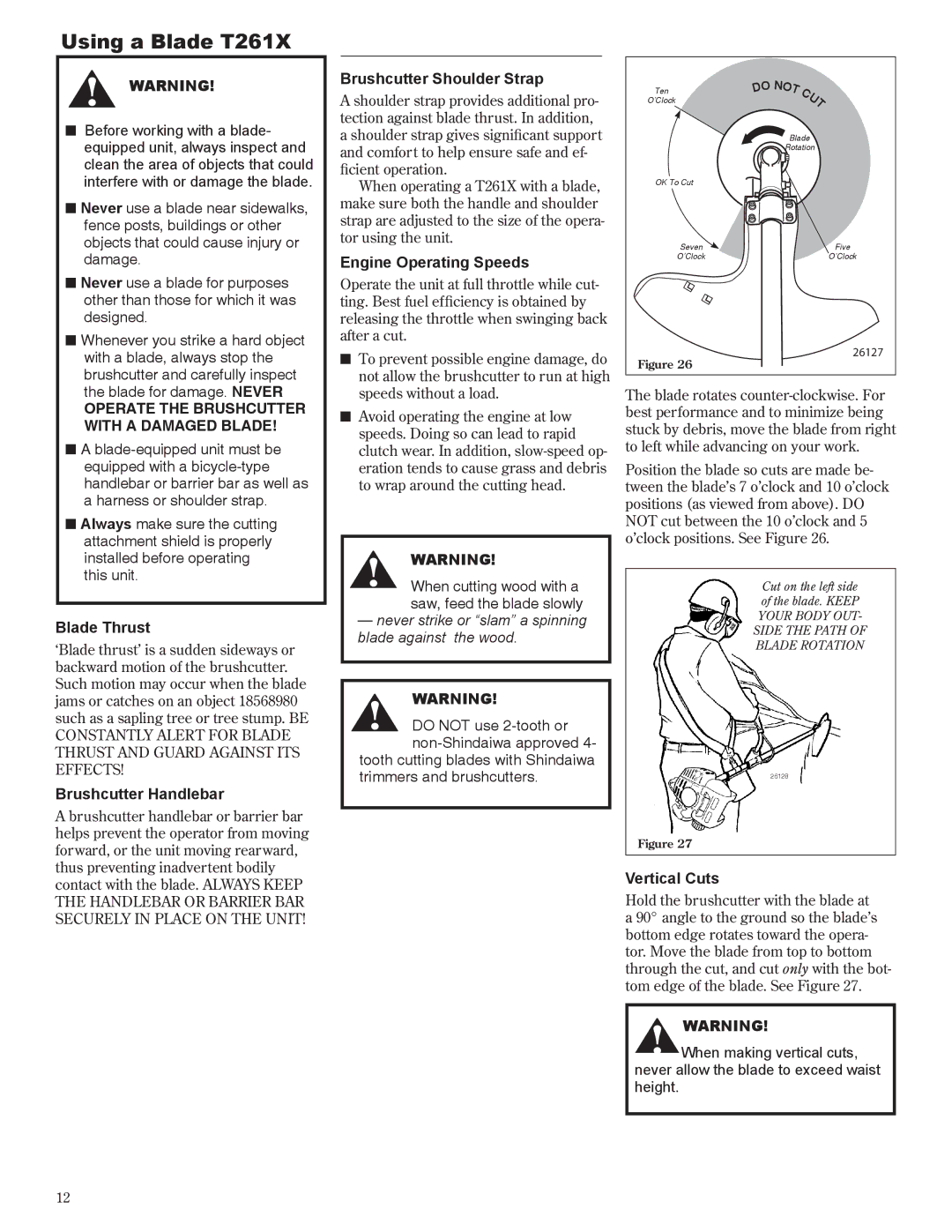
Using a Blade T261X
WARNING!
nBefore working with a blade- equipped unit, always inspect and clean the area of objects that could interfere with or damage the blade.
nNever use a blade near sidewalks, fence posts, buildings or other objects that could cause injury or damage.
nNever use a blade for purposes other than those for which it was designed.
nWhenever you strike a hard object with a blade, always stop the brushcutter and carefully inspect the blade for damage. NEVER
OPERATE THE BRUSHCUTTER WITH A DAMAGED BLADE!
nA
nAlways make sure the cutting attachment shield is properly installed before operating this unit.
Blade Thrust
‘Blade thrust’ is a sudden sideways or backward motion of the brushcutter. Such motion may occur when the blade jams or catches on an object 18568980 such as a sapling tree or tree stump. BE CONSTANTLY ALERT FOR BLADE THRUST AND GUARD AGAINST ITS EFFECTS!
Brushcutter Handlebar
A brushcutter handlebar or barrier bar helps prevent the operator from moving forward, or the unit moving rearward, thus preventing inadvertent bodily contact with the blade. ALWAYS KEEP THE HANDLEBAR OR BARRIER BAR SECURELY IN PLACE ON THE UNIT!
Brushcutter Shoulder Strap
A shoulder strap provides additional pro- tection against blade thrust. In addition, a shoulder strap gives significant support and comfort to help ensure safe and ef- ficient operation.
When operating a T261X with a blade, make sure both the handle and shoulder strap are adjusted to the size of the opera- tor using the unit.
Engine Operating Speeds
Operate the unit at full throttle while cut- ting. Best fuel efficiency is obtained by releasing the throttle when swinging back after a cut.
nTo prevent possible engine damage, do not allow the brushcutter to run at high speeds without a load.
nAvoid operating the engine at low speeds. Doing so can lead to rapid clutch wear. In addition,
WARNING!
When cutting wood with a saw, feed the blade slowly
—never strike or “slam” a spinning blade against the wood.
WARNING!
DO NOT use
tooth cutting blades with Shindaiwa trimmers and brushcutters.
| O N |
|
|
| |
| D | O | C |
| |
Ten |
|
| T |
| |
|
| U | |||
O’Clock |
|
|
| ||
|
|
|
| T | |
![]() Blade
Blade
Rotation
OK To Cut
Seven | Five |
O’Clock | O’Clock |
26127
Figure 26
The blade rotates
Position the blade so cuts are made be- tween the blade’s 7 o’clock and 10 o’clock positions (as viewed from above). DO NOT cut between the 10 o’clock and 5 o’clock positions. See Figure 26.
Cut on the left side of the blade. KEEP YOUR BODY OUT- SIDE THE PATH OF BLADE ROTATION
26128
Figure 27
Vertical Cuts
Hold the brushcutter with the blade at a 90° angle to the ground so the blade’s bottom edge rotates toward the opera- tor. Move the blade from top to bottom through the cut, and cut only with the bot- tom edge of the blade. See Figure 27.
WARNING!
When making vertical cuts, never allow the blade to exceed waist height.
12
